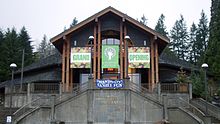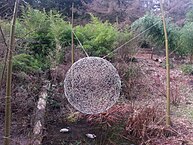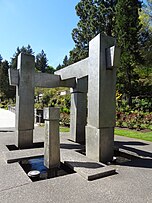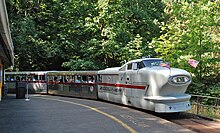
Portland is a port city in the Pacific Northwest and the most populous city in the U.S. state of Oregon. Situated in the northwestern area of the state at the confluence of the Willamette and Columbia rivers, Portland is the county seat of Multnomah County, the most populous county in Oregon. As of 2020, Portland had a population of 652,503, making it the 26th-most populated city in the United States, the sixth-most populous on the West Coast, and the second-most populous in the Pacific Northwest, after Seattle. Approximately 2.5 million people live in the Portland–Vancouver–Hillsboro, OR–WA metropolitan statistical area, making it the 25th most populous in the United States. About half of Oregon's population resides within the Portland metropolitan area.
The Oregon Museum of Science and Industry is a science and technology museum in Portland, Oregon, United States. It contains three auditoriums, including a large-screen theatre, planetarium, and exhibition halls with a variety of hands-on permanent exhibits focused on natural sciences, industry, and technology. Transient exhibits span a wider range of disciplines.

The Oregon Zoo, originally the Portland Zoo and later the Washington Park Zoo, is a zoo located in Washington Park, Portland, Oregon, approximately 2 miles (3.2 km) southwest of downtown Portland. Founded in 1888, it is the oldest zoo west of the Mississippi River.

Forest Park is a public municipal park in the Tualatin Mountains west of downtown Portland, Oregon, United States. Stretching for more than 8 miles (13 km) on hillsides overlooking the Willamette River, it is one of the country's largest urban forest reserves. The park, a major component of a regional system of parks and trails, covers more than 5,100 acres (2,064 ha) of mostly second-growth forest with a few patches of old growth. About 70 miles (110 km) of recreational trails, including the Wildwood Trail segment of the city's 40-Mile Loop system, crisscross the park.
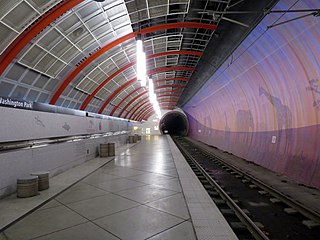
Washington Park is a light rail station in Portland, Oregon, United States, served by TriMet as part of the MAX Light Rail system. Situated between Sunset Transit Center and Goose Hollow/Southwest Jefferson Street station, it is the 17th and 3rd station eastbound on the Blue Line and the Red Line, respectively. The station's two tracks and island platform are part of the Robertson Tunnel beneath Portland's West Hills. Its head house and surface-level plaza occupy the middle of a parking lot surrounded by the Hoyt Arboretum, Oregon Vietnam Veterans Memorial, Oregon Zoo, and World Forestry Center. Washington Park is the only completely underground station in the MAX system. At 260 feet (79 m) below ground, it is the deepest transit station in North America and in the western hemisphere. It is also the seventh-deepest in the world.

The World Forestry Center is a nonprofit educational institution in Portland in the U.S. state of Oregon. Located near the Oregon Zoo in Washington Park, the organization was established in 1964 as the Western Forestry Center, with the actual building opening in 1971.

The Portland Japanese Garden is a traditional Japanese garden occupying 12 acres, located within Washington Park in the West Hills of Portland, Oregon, United States. It is operated as a private non-profit organization, which leased the site from the city in the early 1960s. Stephen D. Bloom has been the chief executive officer of the Portland Japanese Garden since 2005.

Downtown Portland is the central business district of Portland, Oregon, United States. It is on the west bank of the Willamette River in the northeastern corner of the southwest section of the city and where most of the city's high-rise buildings are found.

Hoyt Arboretum is a public park in Portland, Oregon, which is part of the complex of parks collectively known as Washington Park. The 189-acre (76 ha) arboretum is located atop a ridge in the Tualatin Mountains two miles (3.2 km) west of downtown Portland. Hoyt has 12 miles of hiking trails, two miles of accessible paved trails, and is open free to the public all year. About 350,000 visitors per year visit the arboretum.

The Oregon Vietnam Veterans Memorial is an 8-acre (0.03 km2) outdoor war memorial dedicated to Oregonians who served in the Vietnam War. It is located in Portland, Oregon's Washington Park at 45.5120°N 122.71857°W. The memorial was dedicated in 1987, inspired in 1982 by visits to the national Vietnam Veterans Memorial by five veterans and the parents of a Marine killed in Vietnam. Landscape architecture firm Walker Macy of Portland designed the memorial, while construction labor and materials were almost entirely volunteer donations.The font used in the memorial was created for the exclusive use of the Memorial. It was designed by Janis Price, and is called Hoyt, in recognition of the Arboretum.

The Washington Park & Zoo Railway (WP&ZRy) is a 2 ft 6 in narrow gauge recreational railroad in Portland, Oregon's Washington Park with rolling stock built to 5/8 scale. Opened in three stages in 1958, 1959 and 1960, it previously provided transportation between the Oregon Zoo, Hoyt Arboretum, International Rose Test Garden, and the World Forestry Center. The extended line through Washington Park, now out of service but still in place, was about 2 miles (3.2 km) long. The service is currently operating on a 1⁄2-mile (0.80 km) loop completely within the Oregon Zoo grounds. The railway carries about 350,000 passengers per year.

Arlington Heights is a neighborhood in Portland, Oregon known for its grand houses. It is home to Washington Park, the Portland Japanese Garden, the International Rose Test Garden, and the Oregon Zoo.

Laurelhurst is a neighborhood of vintage homes and undulating streets surrounding a park of the same name, straddling the NE and SE sections of Portland. Stone markers flank the entrances to the area. The center of the neighborhood, Coe Circle, contains a gilded equestrian statue of Joan of Arc, which is a World War I war memorial. The Laurelhurst Historic District was officially listed on the National Register of Historic Places in 2019.

The Skidmore Fountain is a historic fountain in Portland, Oregon, United States.

The 40-Mile Loop is a partially completed greenway trail around and through Portland in the U.S. state of Oregon. It was proposed in 1903 by the Olmsted Brothers architecture firm as part of the development of Forest Park. One greenway expert calls it "one of the most creative and resourceful greenway projects in the country."
The following is a timeline of the history of the city of Portland, Oregon, United States.

The A and B Loop is a streetcar circle route of the Portland Streetcar system in Portland, Oregon, United States. Operated by Portland Streetcar, Inc. and TriMet, it is made up of two separate services: the 6.1-mile (9.8 km) A Loop, which runs clockwise, and the 6.6-mile (10.6 km) B Loop, which runs counterclockwise. The route travels a loop between the east and west sides of the Willamette River by crossing the Broadway Bridge in the north and Tilikum Crossing in the south.

Southwest Portland is one of the sextants of Portland, Oregon.
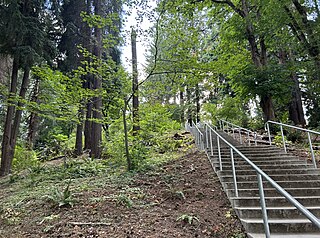
Stearns Canyon is a small canyon located in Portland, Oregon, primarily within Washington Park. It cuts its way south through the Tualatin Mountains from Burnside Street, approximately 1 mile south into the park.










